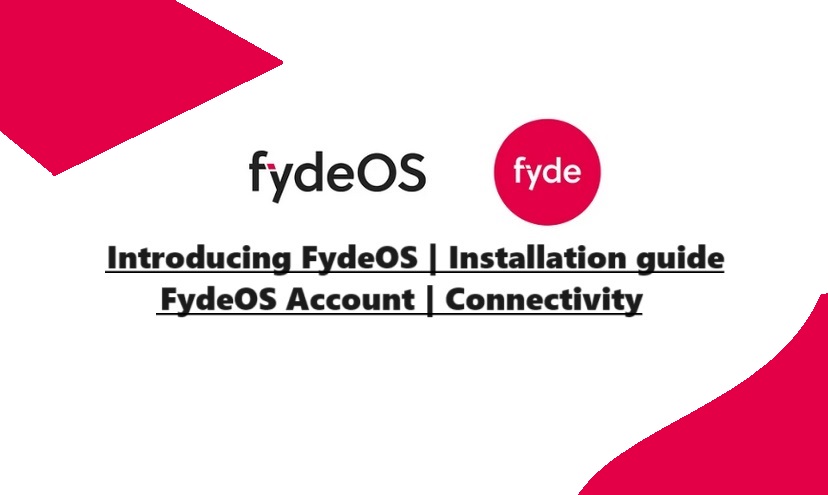in this article, we discuss FydeOS and learn how to use it with Rock Pi Boards.
Introducing FydeOS
FydeOS is a special type of operating system that works with the internet and is built from the Chromium OS project. It can work on many different devices and gives you a quick, safe, and smooth experience when using your computer. It combines the best parts of Chromium to give you a modern-looking interface, fast web browsing, and it can run Android apps and Linux programs. Plus, it gets regular updates to keep your computer secure and up-to-date. If you want a strong, not-too-heavy operating system that’s all about using the web and works on lots of different devices, FydeOS is a great choice.
openFyde is the open-source version of FydeOS. In comparison, FydeOS offers a more stable experience, better performance, and unique features.
How to get FydeOS and Installation guide
Sure, here are the steps in simpler language:
1. Get FydeOS: First, go to the FydeOS website and download the installation file. Make sure you choose the right one for your device. If you’re using openFyde, get the latest image from the release page.
2. Put it on a Drive: From FydeOS v17 (openFyde r114) onwards, you can directly put the downloaded file onto the device you’ll use to start FydeOS. In the past, you had to use a micro SD card first, but now you can skip that step. For certain types of drives like M.2 NVMe/Sata or eMMC, you might need extra hardware like a USB drive enclosure or reader.
3. Use balenaEtcher: Use a tool called balenaEtcher to put the FydeOS file onto a USB drive. It’s easy to use and works on Windows, macOS, and popular versions of Linux. Just download it from their website.
4. Or Use dd Command: If you’re comfortable with it, you can also use the “dd” command to write the file directly to your storage device.
5. Power Up: Once you’ve written the file to your storage device, put it into your Rock5B. Also, connect your keyboard, mouse, and monitor. Then, turn on your Rock5B. That’s it! You’ve finished installing FydeOS/openFyde. Now you can start using your new operating system!
If your screen is black or your operating system doesn’t start up, here’s what you can do:
1. Check Your Device: If you’re using a device like Rock5B, it’s different from regular computers, so the startup process is also different. Make sure your device’s firmware (SPI firmware) is set up to start from the storage device you installed FydeOS on. Usually, this storage device is an NVMe or Sata SSD in the M.2 slot.
2. Troubleshoot SSD Booting: If you’re having trouble starting from the SSD in the M.2 slot, double-check that your device’s firmware (SPI firmware) hasn’t been changed or damaged. If you’re not sure, you can look at the official wiki for help on fixing it.
Remember, these steps can help you get your operating system up and running if you’re having trouble, especially with ARM-powered devices like Rock5B. If unsure, you can refer to the official wiki for repair.
Log in to your FydeOS Account
To set up your FydeOS device for you, just type in your FydeOS Account email or phone number along with your password.
– If you don’t have a FydeOS Account yet, you can make one. On certain FydeOS devices, you might see ‘Create new account’ when you click ‘More options.’
– If you want to use your FydeOS device without making an account, just pick ‘Browse as Guest.’
– If you’re having trouble logging in, reach out to the FydeOS Community for tech help.
Once you’re logged in, all your bookmarks, extensions, and apps will show up automatically.
Connect to Wi-Fi & other networks
Turn on Wi-Fi:
1. Click the time at the bottom right.
2. Choose your Wi-Fi network. If you see your network name and signal strength, you’re already connected.
3. Turn on Wi-Fi. Your device will search for available networks.
Connect to a Network:
-Open Network: Just select it. Remember, your info may be visible.
-Secure Network: Choose the network, type the password, and click Connect.
-Unlisted Network: Select “Join other networks,” enter details, and click Connect.
Connect to WPA2 Enterprise Network:
1. Make sure your certificate is installed. if not, please follow these steps:
- Open Chromium.
- In the address bar, type
chrome://settings/certificatesand press Enter. - Select Authorities.
- Using information from your administrator, look for your server certificate in the list. If the server certificate isn’t installed, your administrator might ask you to install the server certificate.
- If you’re connecting to an EAP-TLS network, you might need to install the user certificate.
2. Click the time, then Settings > Network > Add Wi-Fi > Advanced. Enter network info and click Connect.
Find MAC or IP Address:
1. Click the time, and select Wi-Fi network.
2. Click “Information.” Your IP and MAC address are shown.
Supported Wi-Fi Networks:
– Open networks
– Secure networks using WEP, WPA, or WPA2 (preferable)
– Standards: 802.11 a/b/g/n and 802.11ac for AC-equipped devices.
Useful Reference Links:

